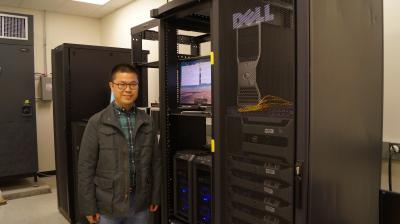"Obviously, we cannot go inside of the Earth to see what is happening there. However, the process of mantle convection should comply with fundamental physics laws, such as conservation of mass, momentum and energy. What we have done is to simulate the process of mantle convection by solving the equations which controls the process of mantle convection," says Li.
It has long been suggested that the Earth's mantle contains several different compositional reservoirs, including an ancient more-primitive reservoir at the lowermost mantle, recycled oceanic crust and depleted background mantle. The complex geochemistry of lava found at hotspots such as Hawaii are evidence of this. The various compositional components in hotspot lava may be derived from these different mantle reservoirs. The components could become embedded in and carried to the surface by mantle plumes, but it is unclear how individual plumes could successively sample each of these reservoirs.
Joined by his advisor Allen McNamara, geodynamicist and associate professor in Arizona State University's School of Earth and Space Exploration, and seismologist and SESE professor Ed Garnero, Li and his collaborators' numerical experiments show that plumes can indeed carry a combination of different materials from several reservoirs.
According to the simulations, some subducted oceanic crust is entrained directly into mantle plumes, but a significant fraction of the crust—up to 10%—enters the more primitive reservoirs. As a result, mantle plumes entrain a variable combination of relatively young oceanic crust directly from the subducting slab, older oceanic crust that has been stirred with ancient more primitive material and background, depleted mantle. Cycling of oceanic crust through mantle reservoirs can therefore explain observations of different recycled oceanic crustal ages and explain the chemical complexity of hotspot lavas.
"Our calculations take a long time – more than one month for one calculation – but the results are worth it," says Li.

This video shows a numerical simulation of Earth's deep mantle. The top panel is temperature and the bottom panel is composition which includes three components: the more-primitive reservoir at the lowermost mantle (cyan), the subducted oceanic crust (yellow) and the depleted background mantle (black).
Notice that as the oceanic crust is subducted to the lowermost mantle, some part of it is directly carried up to the surface by plumes which a large fraction of it episodically enters the more-primitive reservoir. As a result, plumes forming on top of the more-primitive reservoir could simultaneously entrain a combination of compositional components to the surface, including (a) relatively young oceanic crust, (b) ancient more-primitive material stirred with older oceanic crust, and (c) background, depleted mantle.
(Photo Credit: Mingming Li and Allen McNamara)

Graduate student Mingming Li in collaboration with ASU professors Allen McNamara and Ed Garnero developed new simulations that depict the dynamics of deep Earth. Here, Li stands in front of the massive computer clusters required for running the calculations.
(Photo Credit: Allen McNamara)




Comments